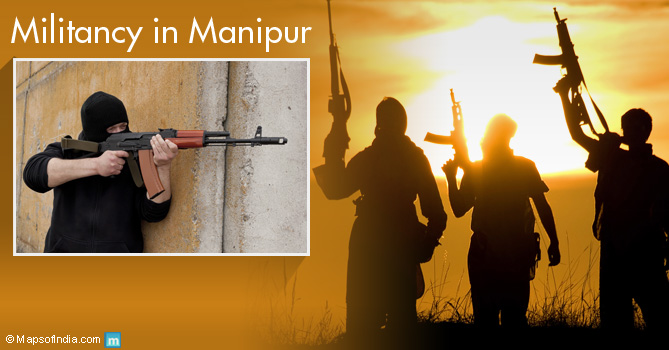Among all the North Eastern states of India, Manipur is the worst affected in terms of militancy and insurgency. Today, there are at least 12 insurgent outfits active in the state and even today the Armed Forces (Special Powers) Act, 1958, imposed by the Government of India remains in force in the state.
1. Insurgent groups in Manipur
The first militant party formed in Manipur was the United National Liberation Front (UNLF). It was founded in 1964. Between 1977 and 1980, three more militant groups were formed: the People’s Liberation Army of Manipur (PLA), People’s Revolutionary Party of Kangleipak (PREPAK) and the Kangleipak Communist Party (KCP). On the other hand, the rise of Naga nationalism in the neighbouring state Nagaland led to the formation of two militant groups in Manipur: Isak-Muivah faction of National Socialist Council of Nagaland (NSCN-IM) and from the hills of Nagaland there was the Khaplang faction of National Socialist Council of Nagaland (NSCN-K). Clashes between the two outfits further aggravated tensions. Then there were the Kuki tribals who began forming their own insurgent groups to protect themselves from alleged Naga violations. During the 1990s there were several ethnic group clashes in the state. Other ethnic groups like Paite, Vaiphei, Pangals and Hmars established their own militants groups. The People’s United Liberation Front (PULF), an Islamist outfit, is protecting the interests of the Manipuri Muslims or the ‘Pangals’.
2. Reasons for militancy
On 15 October 1949, Manipur became a part of the Union of India. However, the inclusion of Manipur in India itself was the first cause of the rise of insurgent organisations, which wanted to make Manipur an independent state, dismissing the inclusion with India as involuntary. On 21 January 1972, Manipur became a separate state of the Indian Union. But even then insurgency continued and the number of militant outfits kept on increasing. In 1980, Manipur was declared as a disturbed area. All these militant groups have been demanding a separate independent Manipur. Also, the militant groups mushroomed to protect Manipur from regional conflicts in the neighbouring states, particularly Nagaland. Most of the militant groups have their own vested interests in the name of the welfare of the people and the state. Not many ‘surrenders’ have been reported from Manipur. The militants are armed with an efficient intelligence network and high-class fire power as a result of which they have been able to carve out a number of liberated zones across the State.
3. Inefficiency of the security forces
In Manipur, most of the militant groups are still active and the region is in the grip of terrorism. The security forces employed by the Government of India have made little difference. In fact many insurgent groups such as UNLF, PLA, KYKL, PREPAK and the KCP have attacked the security forces from time to time. However, the insurgent groups do not target the state police personnel, unless and until circumstances demand it. The regular act of attacking the Army and the central para-military personnel by the militants is evident of the fact that the militants want to create a division between Manipur and India and to secure important popular support. By the end of 2007, the security forces could manage to dislodge the militants from only a few zones.
4. Effects of militancy in the state
The reign of terror has continued in other forms like attacking VIPs and ministers, and kidnapping children so as to train them to be militants. Due to the growing militancy and lack of investments, not much infrastructural development has taken place in the state. There is growing unemployment in the state. More and more unemployed youths have started joining militant groups. The extortion cases are also increasing. The insurgent groups have resorted to extorting from almost all places including temples, churches, schools, colleges, hospitals and commercial establishments. This has led to closure of a number of establishments in the State. The insurgents continue to terrorise and extort and the public has little option but to obey their orders.
5. Peace efforts by the Government
The first attempt by the government to reduce insurgency was by arresting many insurgent leaders during the war of liberation in Bangladesh in 1971. This led to a gradual decline in militancy in Manipur. However, with the establishment of PLA in 1978, insurgency was again revived. In 1985, the Armed Forces Act was imposed and it is still active. In 1990, much to the relief of the people, few militant groups of the kuki tribes surrendered to the Government. In spite of the government’s serious attempts at peace talks, nothing effective had resulted and in most cases, the peace talks were rejected by the outfits. On its part, the Manipur state government has been continuously urging the militants to surrender and lay down their arms. The state government is offering Rs. five Lakh as fixed deposit and a monthly stipend of Rs.5000 for those insurgents who surrender.





